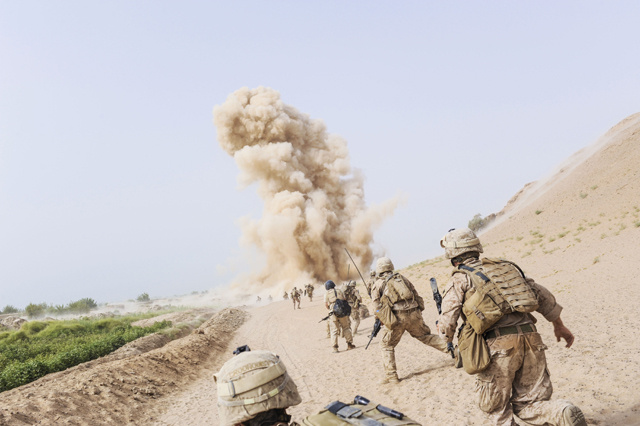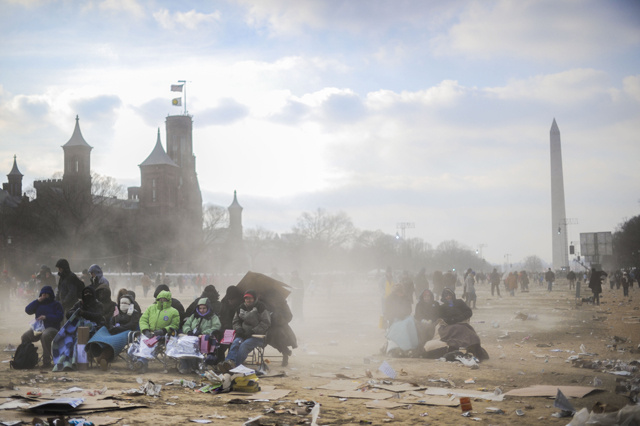Earlier this month, a group of high school students went to Dundas Square in Toronto to shoot a video as part of the far-reaching #SaveAleppo campaign. They stopped pedestrians on the streets and held up pictures of a war-torn Syria, then asked the same strangers what they knew about the crisis. The pictures included children digging through dirt for dry bread, and crowds looking up to the sky for the next barrel full of oil, which the Assad regime have been using as bombs, to drop from the sky. Their video garnered over 10,000 views in its first 24-hour cycle, and as of this writing it has almost 70,000 hits.
The organizer of this demonstration was a 17-year-old student named Noor Mamlouk, who says it is her duty as a human to defend against the atrocities in Syria. She lives in Canada, but was born in Syria, and is considered to be one of the brightest young activists in the Canadian-Syrian community.
The following is an edited version of my interview with Noor about why she thinks it’s so important to get the word out about one of the planet’s most underreported and devastating conflicts.
VICE: What first inspired you to work as an activist?
Noor Mamlouk: I was 13 when the revolution began, and I think I felt inspired right away. I was at home in Qatar, where I lived before I moved to Canada, and it was on Al Jazeera. I remember my mom being shocked. When the Arab Spring started I remember my friends and I were in a car on our way to eat, and the Egyptian revolution had just toppled Mubarak. I remember my friend who is Sudanese saying: “I bet if this happened in Sudan, they’d just go out for an hour and then just leave.” And I had said: “I bet if Syria protested it would last for a week because of how atrocious the government is, and then they’d go back,” but now it’s been over three years. I didn’t expect it to last this long. But I was 13 and I knew nothing about politics.
When did you start becoming active?
Well, I would go to protests with my dad in Qatar as soon as the revolution began. Those protests were really cool because we would try to make them connected with the protests in Syria and we would chant and hold each other’s shoulders and be united with protests across the world. Those were the first steps. I was also using Twitter to see what was going on. So I started using that to talk about what was happening in my opinion, and it became more emotional.
Emotional, how?
When I realized this what was happening to kids my age, it was really hard. There was a boy named Hamza al Khatib who was also 13 and he was killed in Syria after being caught up in a protest. He was missing for weeks, and then the government delivered his body in a bag to his parents. They told them they had to say on Syrian media that the rebels had done this to their son. There was a child who had his jaw blown out, another girl who was beheaded; there was a two-month old baby who died. So just the fact that it was happening to kids my age and younger, who were getting tortured for basically doing nothing was something that really affected me so I tried to get people my age involved.

Photo of Noor and fellow Like activists, mid-demonstration. Photo via Mohamad Ojjch.
How did you get them involved?
I realized that just tweeting wasn’t going to do anything and that raising awareness was really important as well. So at my school a group of people and myself decided to have a Syria week to raise awareness. We had a refugee our age come in to talk about what was going on. That was a start. Since then I have been in so many protests, too. When I moved to Canada from Qatar, I joined different organizations that gave me opportunities to speak at universities and volunteer as much as possible. Then with this latest video, I was able to get my friends from school here to help with holding signs—and I think it really helped.
What does it mean to you to be an activist?
I think it’s more about being a human. It’s everyone’s duty to at least speak up or know about what’s going on. It’s my moral duty as a human. There was a holocaust, and what happened in Rwanda and Bosnia… all these things that have happened in history, and we are still letting it happen again in Syria. 200,000 people have been killed in three years, that’s a lot of people. It’s hard to believe just the fact that not a lot of people here still know about it and there is so much confusion in the media about what is going on. Forget the politics. Just look at it and see that little kids are dying because of chemical weapon attacks. Whether those kids are Syrian or from any other nation in the world, it shouldn’t matter. So, it’s not just an activism thing, it’s to know what’s going on and speak out about it.
How many days a week are you concentrating on activism?
Every single day. The first thing I do when I get up is check the news on various social media outlets to see what’s going on. There are several blogs I follow from people not just in Syria, but people in Canada who blog direct news from places like Palestine. It’s easier than reading the newspapers. And sometimes I am involved in events up to three times a week.
How important has social media been to you and other activists?
It is very important. In all the revolutions coming from the Arab Spring, social media has been an essential part. For me, it’s how I got started, and how I met other activists. The most basic thing someone can do, to be part of these revolutions, is tweet. Also, when you see a whole bunch of people who are tweeting about Syria using the same hashtag or writing blogs, it becomes accessible for everyone and makes it really powerful. The video that we made, for example, got popular and went all over the world because of social media.
Right, so something like the #SaveAleppo or #SaveSyria campaign wouldn’t be possible…
Exactly, because the only real way to get news out of the Middle East is from people like the guy in Aleppo who started the campaign and then others from around the world joining in. There were candlelight vigils in DC and things happening all over the world as result of what he started. There is literally a Twitter family because we can all follow each other from different countries in the Twitterverse. We released our video as #SaveSyria because I don’t think a lot of people in Canada know what Aleppo is, but it is part of the same campaign.
Is there anything that surprised you while you were talking to people on the sidewalk in Toronto about Syria?
Yes. Many people seemed really interested in what was going on in Syria but didn’t know a lot about it. Even though we have been on the streets for three years creating awareness, there are still so many people who have no idea what is happening. But, all you have to do is turn the news on for a couple minutes and it’s there. That’s why in this video we decided to use #SaveSyria instead of Aleppo because some people might know about Aleppo—but everyone should know about Syria by now.
How did people respond to you?
We got some amazing reactions; a lot of people were shocked by what’s happening right now in the 21st century. The chemical weapon attacks, the houses that look like they’re from World War II… it’s happening now, and a lot of people aren’t aware of that. I think we have done so much in the last three years to create awareness, but we should still get out on the streets more. Especially kids my age. People were coming up to the people holdings signs and taking selfies. We were getting them interested.

Noor, outside of City Hall. Photo via Angela Hennessy.
Why do you think that Canadians can be so unaware of what’s happening?
Well, Canada is a huge country and the media here covers everything. Also, Canada has its own problems. But at the same time—and I see this in my high school a lot—everyone just lives in their own bubble. There are a lot of people who, if they were informed of what was really going on, they would care. Even outside the political aspect of who’s right and who’s wrong (and you should try to understand that), from the humanitarian perspective… there are kids my age and younger who are dying, because their parents are asking for basic human fundamental rights. I think that would touch a lot of people, and more media coverage would be amazing.
Why do you think there is a lot of confusion about what is happening in Syria in North America in general?
I think people forgot that it was a revolution. And it is still is a revolution, because the American and Canadian, but especially the American news media tend to focus on the Jihadists and what they are doing in Syria and talk about them cutting people’s heads of, which isn’t right at all, and they forgot about the fact that this all started because people my age put graffiti on a wall and asked for freedom. They forgot the fact that it’s a revolution. And they don’t like to cover the fact that liberated cities are basically running themselves right now without any government interference.
Why do you think it is so important for younger people to be involved?
You can’t just have an older generation doing everything and organizing stuff, because in the end it is going to be us who are going to make a change and figure stuff out for what is happening in Syria and the rest of the world. Yes, the Syrian community is tired. We’re not getting as much people out as we used to in the first year, and so I think that’s why it’s up to people my age to get things going now. The people who are older than me have families and jobs and have been doing it for the past few years, and I think they are exhausted. We are supposed to be the creative ones with new ideas and we have more energy. After shooting this video, a lot of my friends now want to do something.
Do you have hope for the future?
Yes, definitely. Even the people in Syria are still continuing their every day lives. There are still artists, and musicians, and others who are speaking out and who refuse to obey the regime. How can I say there is now hope? There is hope. Everyone outside Syria should have hope now. No one can give up hope, especially if people in Syria haven’t. This has been one of the most brutal government crackdowns that has ever happened in the Middle East, so we should have hope.
Is that your message?
Yes, you can’t give up on the Syrian revolution or any revolution. Some people down there are living through some of the most horrible things that have have ever happened in history, and they still choose to live. They still chose to educate their children in some way, they still write and blog and tweet and draw and graffiti and everything else. They still live as much as they can under the circumstances.
Do you want to go back to Syria one day?
Definitely. Even when I think about what I want to do in university, I think about what I can do to affect Syria and help rebuild the country. Because we are going to go back and we are going to rebuild, we need to reestablish society. I don’t know what I want to do in the future, but it will have something to do with helping. No matter what, I want to go back and help. Anything I can do.



 BUILT TO SPILL
BUILT TO SPILL TYPE O NEGATIVE
TYPE O NEGATIVE RUSH/LOVE
RUSH/LOVE PINBACK
PINBACK LIFE WITHOUT BUILDINGS
LIFE WITHOUT BUILDINGS BREADWINNER
BREADWINNER SCHARPLING AND WURSTER
SCHARPLING AND WURSTER HEAVENS TO BETSY
HEAVENS TO BETSY MEDICINE
MEDICINE GRANT HART
GRANT HART DINOSAUR JR.
DINOSAUR JR. THE PIXIES
THE PIXIES DRESDEN DOLLS
DRESDEN DOLLS THE MOLES
THE MOLES CARDINAL
CARDINAL LIARS
LIARS CAVE IN
CAVE IN TAME IMPALA
TAME IMPALA XIU XIU
XIU XIU FLAMING LIPS
FLAMING LIPS

































































